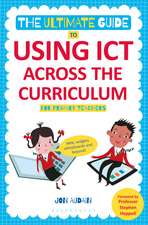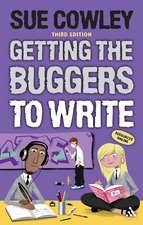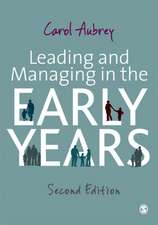A Developmental Approach to Early Numeracy: Helping to Raise Children's Achievements and Deal with Difficulties in Learning
Autor Carol Aubreyen Limba Engleză Paperback – 30 noi 1999
Under-achievement in maths is a growing concern for many teachers. This book shows how a developmental approach to teaching maths can help to both identify difficulties and raise children's achievement. Beginning with the Early Years, age - focused chapters outline some of the strategies that can be used to identify those in need of special teaching. Practical examples show how these strategies can be applied in classroom situations.
Beginning with the early years, age-focused chapters look at:
the knowledge children develop outside school
how teachers can assess and build on that knowledge
children's misunderstandings in maths, and how to remedy these.
the knowledge children develop outside school
how teachers can assess and build on that knowledge
children's misunderstandings in maths, and how to remedy these.
This book also outlines some of the strategies that can be used to identify those in need of special teaching. Practical examples show you how these strategies can be applied in classroom situations. Each chapter is closely linked to the requirements of the National Numeracy Strategy, and example lesson plans and activities are included detailing ways of using recommended strategies within the numeracy hour.
Preț: 104.03 lei
Nou
Puncte Express: 156
Preț estimativ în valută:
19.91€ • 20.57$ • 16.57£
19.91€ • 20.57$ • 16.57£
Carte tipărită la comandă
Livrare economică 26 martie-09 aprilie
Preluare comenzi: 021 569.72.76
Specificații
ISBN-13: 9781841900094
ISBN-10: 1841900095
Pagini: 144
Dimensiuni: 210 x 297 x 8 mm
Greutate: 0.36 kg
Editura: Bloomsbury Publishing
Colecția Continuum
Locul publicării:London, United Kingdom
ISBN-10: 1841900095
Pagini: 144
Dimensiuni: 210 x 297 x 8 mm
Greutate: 0.36 kg
Editura: Bloomsbury Publishing
Colecția Continuum
Locul publicării:London, United Kingdom
Cuprins
Introduction; Chapter 1: Mathematics and the role of the SENCO; Chapter 2: A sound beginning; Chapter 3: All sixes and sevens?; Chapter 4: Summing up eight- and nine-year-olds; Chapter 5: Improving the achievements of ten- and eleven-year-olds; Index















